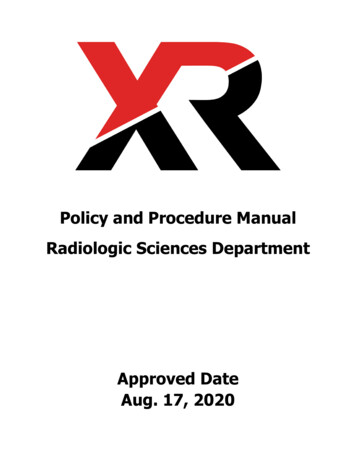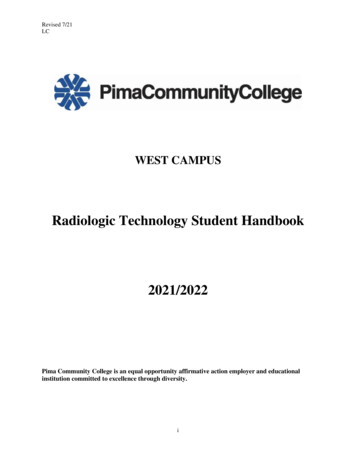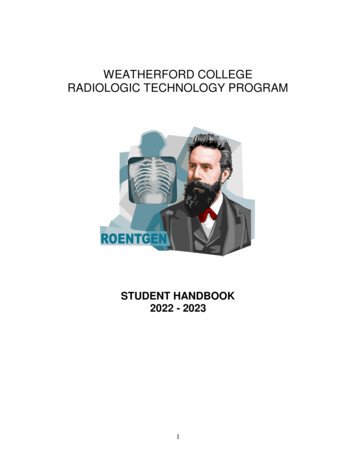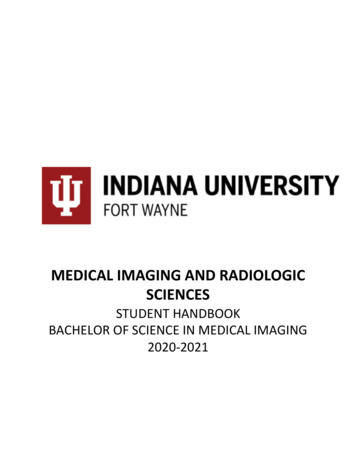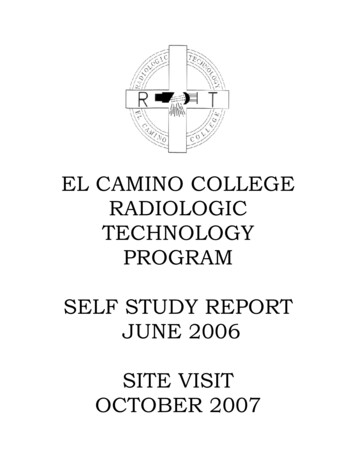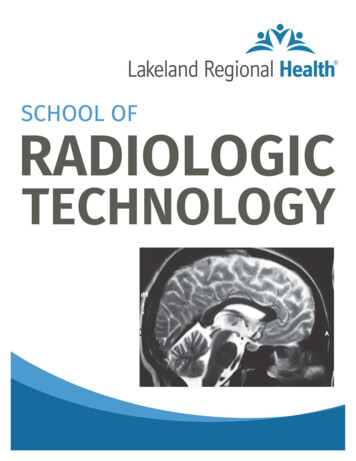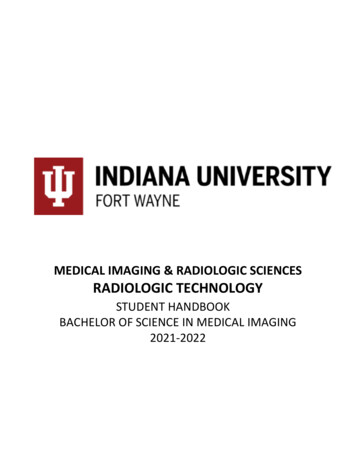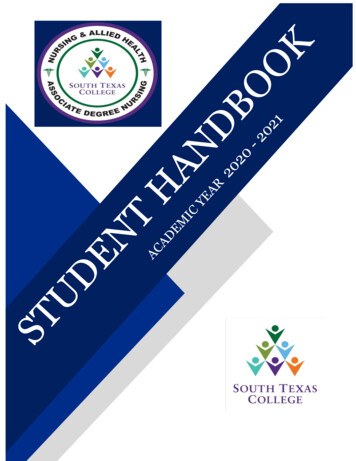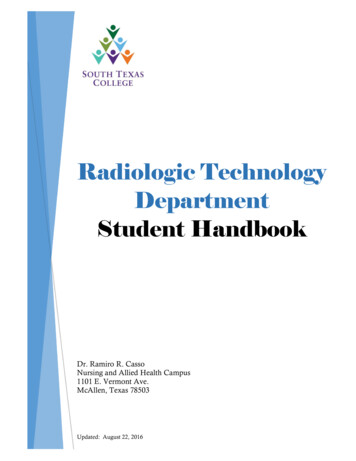
Transcription
Radiologic TechnologyDepartmentStudent HandbookDr. Ramiro R. CassoNursing and Allied Health Campus1101 E. Vermont Ave.McAllen, Texas 78503Updated: August 22, 2016
TABLE OF CONTENTSStudent Handbook Acknowledgement .4Radiologic Technology Degrees and Certificates 5Radiologic Technology Program, Associate of Applied Science DegreeDiagnostic Medical Sonography Program, Advanced Technical CertificateComputed Tomography Program, Certificate556Radiologic Technology Faculty and Staff Contact Information 7Mission Statement and Department Objectives . 8Comprehensive Vision, Mission and Philosophy Statements8Department Objectives8Curriculum Foundation and Competencies9Radiologic Technology Program, Associate of Applied Science Degree . 12Admission Requirements12Radiologic Technology AAS Degree Plan12Course Registration13Program Costs13Radiologic Technology Program Dress Code14Radiation Dosimeters16Clinical Competency Requirements18General Procedures During Clinical/Practicum Sessions18Graduation Requirements19ARRT Radiography Certification19Diagnostic Medical Sonography Program, Advanced Technical Certificate . 22Admission Requirements22Diagnostic Medical Sonography ATC Curriculum22Course Registration22Program Costs23Diagnostic Medical Sonography Program Dress Code23Clinical Competency Requirements25General Procedures During Clinical/Practicum Sessions25Graduation Requirements26ARDMS Sonography Certification26General Student Standards . . . 29Grade Requirements29Examinations, Quizzes and Assignments29Disciplinary Action31Email31Cell Phones and Electronic Devices32Emergency am Readmission35Classroom Management35Student Employment36Student Organizations36Behavior Expectations During Off-Campus Events37Clinical and Practicum Standards . 38Clinical Requirements382
Clinical Site and Travel ExpectationsAttendance Roster ProcedureMerits and DemeritsClinical BreaksJCAHOClinical Competency EvaluationsStudent Simulation SessionsRadiation Safety3838393940404041Equal Opportunity Statements . 44Developmental Studies Policy Statement44Equal Education and Equal Employment Opportunity44Title IX Statement44Pregnant and Parenting Students44ADA Statement44Veterans Statement44Student Agreements . 45Code of Practice Agreement45Professional Standards Agreement45Radiation Safety Agreement45Appendices 46Appendix A46Appendix B47Appendix C50Appendix D513
STUDENT HANDBOOK ACKNOWLEDGEMENTThe Student Handbook established by the Radiologic Technology Department does not conflict withthe policies and procedures in effect for all students of South Texas College and/or the standards ineffect for all NAH Program students, but may be more specific than those written in the South TexasCollege Catalog and/or the Division of Nursing & Allied Health Student Handbook.Students are required to adhere to the Radiologic Technology Department Student Handbook andthe Division of Nursing & Allied Health Student Handbook upon admission to each respectiveprogram within the department.Students enrolled in prerequisite introduction courses in any respective program within theRadiologic Technology Department are required to adhere to the Division of Nursing & AlliedHealth Student Handbook.4
RADIOLOGIC TECHNOLOGY DEGREESAND CERTIFICATESRADIOLOGIC TECHNOLOGY PROGRAM,ASSOCIATE OF APPLIED SCIENCE DEGREEThe Associate of Applied Science (AAS) Degree in Radiologic Technology at South Texas Collegeis an approved program by the Southern Association of Colleges and Schools AccreditationGuidelines. The program provides educational and clinical experience that result in extensiveknowledge in patient care, radiographic procedures, examination techniques, equipment operation,radiation protection, and image production and evaluation. Throughout the clinical and practicumaspects of the program, students will train in various medical facilities with experienced radiologictechnologists.Students are trained for employment as entry-level radiologic technologists in hospitals, outpatientimaging centers, mobile imaging services, and additional medical facilities. Upon completion of theprogram, graduates are eligible to sit for the national certification examination for RadiologicTechnology administered by the American Registry of Radiologic Technologists (ARRT).Successful completion of this exam results in the designation of the title as a Registered Technologistin Radiography, or R.T. (R) (ARRT). The state of Texas also requires that individuals approved tosit for the national certification examination also apply for state licensure before being allowed topractice in this state.DIAGNOSTIC MEDICAL SONOGRAPHY PROGRAM,ADVANCED TECHNICAL CERTIFICATEThe Diagnostic Medical Sonography Advanced Technical Certificate (ATC) at South Texas Collegeis an approved program by the Southern Association of Colleges and Schools AccreditationGuidelines. The program provides educational and clinical experience that result in extensiveknowledge in ultrasound physics and instrumentation, use of Doppler imaging, and cross-sectionalanatomy and pathophysiology in the abdomen, pelvis, obstetrics, gynecology, and superficialstructures. Throughout the clinical and practicum aspects of the program, students will train invarious medical facilities with experienced sonographers.The Diagnostic Medical Sonography Program is an extension of the STC Radiologic TechnologyProgram. Application requirements for entrance into the program for 2017 will include an Associateof Applied Science Degree in Radiologic Technology acquired in an accredited program, currentcertification as a registered technologist by the American Registry of Radiologic Technologists(ARRT), and current licensure by the Texas Department of State Health Services or Texas MedicalBoard.Effective in 2018, application requirements will change and entrance into the program will beextended to individuals who have earned an associate degree in additional selective nursing andallied health professions. The Radiologic Technology Department is currently revising the newselective admissions criteria.Upon successful completion of the program, students will receive an Advanced Technical Certificatein Diagnostic Medical Sonography. Students will also be competent to challenge the abdomen andobstetrics specialty examinations, which are two of the various specialties offered by the AmericanRegistry for Diagnostic Medical Sonography (ARDMS) national examination.5
COMPUTED TOMOGRAPHY PROGRAM,CERTIFICATEThe Computed Tomography (CT) Certificate Program at South Texas College is designed to providean opportunity for professional and personal advancement in the medical imaging profession forcertified radiologic technologists. The CT Program consists of one mandatory didactic course andan optional clinical course. Registered technologists who are not currently employed in CT oremployed part-time in CT may opt to enroll in the clinical course. Students in this course will beassigned to various clinical sites in order to complete their clinical training. Registered technologistswho are currently employed full-time in computed tomography may be exempt from the clinicalcourse and may complete their clinical hours at their place of employment.6
South Texas CollegeRadiologic Technology DepartmentFaculty and Staff Contact InformationDr. Ramiro R. Casso Nursing and Allied Health CampusPhysical Address:1101 E. Vermont Ave.McAllen, TX 78503Mailing Address:P.O. Box 9701McAllen, TX 78502-9701Crystal BirdProgram ChairOffice 1502Phone: (956) 872-3101Email: cbird@southtexascollege.eduClaudia ArteagaRadiology FacultyOffice 1602Phone: (956) 872-3085Email: carteaga 1641@southtexascollege.eduLinda CuellarRadiology FacultyOffice 330Phone: (956) 872-3134Email: rcuellar2@southtexascollege.eduMildred MarroquinRadiology FacultyOffice 1602APhone: (956) 872-3185Email: mmarroquin@southtexascollege.eduEunice SaucedaRadiology FacultyOffice 329Phone: (956) 872-3108Email: esauceda 1095@southtexascollege.eduAngie ReyesRadiology Faculty SecretaryOffice 131Phone: (956) 872-3049Email: reyesang@southtexascollege.edu7
MISSION STATEMENT AND DEPARTMENT OBJECTIVESCOMPREHENSIVE VISION, MISSION AND PHILOSOPHY STATEMENTSVisionOur vision is to educate and develop highly qualified technologists in the field of medical imaging inorder to improve the health of patients within our communities.In achieving our vision, the Radiologic Technology Department strives to: Demonstrate integrity in representation to communities of interest and the public in pursuitof educational excellence in the field of diagnostic imaging; Provide learning activities that promote the synthesis of theory, use of current technology,competent clinical practices and professional values within the radiology discipline; Assure the department’s organizational and administrative structure promotes and supportsquality and effectiveness of the radiology educational process; Develop a prepared workforce of highly qualified technologists to serve the public throughcommunity service and continuing education.Mission StatementThe mission of the Radiologic Technology Department is to prepare individuals to excel in patientcare, performance in diagnostic procedures, and become integral members of the health care team.The Radiologic Technology Department aspires to attain our mission by: Maintaining high standards of excellence in education; Creating an environment in which the development of human potential is the highestpriority; Offering equal opportunity for all qualified students; Providing service to the community and opportunity for lifelong learning; Recognizing the cultural, racial and ethnic diversity of individuals and communities.PhilosophyWe value the art of innovation, creativity, and leadership in our pursuit to educate the future leadersof the radiology community. The Radiologic Technology Department also values the use of moderninformation technology throughout the educational experience as a means of achieving our goals.DEPARTMENT OBJECTIVESThe Radiologic Technology Department has adopted the following objectives for the programs andcertificates offered within the department:1. A thorough knowledge of radiation protection and safety in diagnostic imaging proceduresto include the principles and concepts involving basic interactions of radiation and/or soundwaves with matter and possible biological effects.2. Knowledge and demonstration of practical application in the professional and technicalaspects of patient care related to medical imaging procedures.3. Skill in demonstrating respect for interpersonal relationships including moral and ethicalresponsibilities to increase effective communication and empathy for the patient.4. Provision of an understanding of the goals, philosophies and organization of the RadiologicTechnology Department, affiliate radiology departments and an appreciation of the career indiagnostic imaging through knowledge of medical history as well as the evolution ofradiology and its professional organizations.8
5. Proficiency in comprehending the principles of the various modalities of imaging available tothe profession and recognizing the common factors in the production of a diagnostic imageregardless of the imaging system used.6. Skill in all types of diagnostic imaging, maintain and/or troubleshoot malfunctions inprocessing systems, evaluate radiographs for the presence of artifacts and the ability tocorrect or compensate for processing errors.7. Proficiency in applying the principles of structure and function within the human body,comprehensive study of physiology of the various systems, and the ability to correlate theanatomy from a topographic and sectional standpoint.8. Ability to comprehend medical terminology, follow directions and communicate effectivelywith others.9. Understanding of disease entities and their influence on diagnostic techniques, enabling thestudent to produce optimal diagnostic images and ensure effective care to the patient.10. Familiarization with routine diagnostic procedures and supplementary techniques such asultrasound, computerized tomography, angiography, nuclear medicine, radiation therapy,magnetic resonance imaging, cardiovascular angiography and mammography.11. Competence in cardiopulmonary resuscitation.12. Assure that both clinical and didactic education relates to practice needs, prepare competenttechnologists and foster mutual appreciation and collaboration among the healthprofessions.CURRICULUM FOUNDATION AND COMPETENCIESSouth Texas College is determined to prepare students with the knowledge and skills needed tosucceed in today’s dynamic work environment. The 1991 report What Work Requires of Schools: ASCANS Report for America 2000 of the Secretary's Commission on Achieving Necessary Skills(SCANS) identified a three-part foundation and five basic competencies that have come to serve asguiding principles for most career-oriented curricula. Toward this end, the following SCANSfoundation and competencies have been incorporated into the Radiologic Technology Departmentcurriculum:SCANS: Three-Part Foundation Basic Skills: Reads, writes, performs arithmetic operations, listens, and speaks.A. Reading: Locates, understands, and interprets written information in prose and indocuments such as manuals, graphs, and schedules.B. Writing: Communicates thoughts, ideas, information, and messages in writing; andcreates documents such as letters, directions, manuals, reports, graphs, and flowcharts.C. Arithmetic: Performs basic computations and approaches practical problems bychoosing appropriately from a variety of mathematical techniques.D. Listening: Receives, attends to, interprets, and responds to verbal messages and othercues.E. Speaking: Organizes ideas and communicates orally. Thinking Skills: Thinks creatively, makes decisions, solves problems, visualizes, knows howto learn, and reasons.A. Creative Thinking: Generates new ideas.B. Decision Making: Specifies goals and constraints, generates alternatives, considersrisks, and evaluates and chooses best alternative.C. Problem Solving: Recognizes problems and devises and implements plan of action.9
D. Seeing Things in the Mind's Eye: Organizes and processes symbols, pictures, graphs,objects, and other information.E. Knowing How to Learn: Uses efficient learning techniques to acquire and apply newknowledge and skills.F. Reasoning: Discovers a rule or principle underlying the relationship between two ormore objects and applies it when solving a problem. Personal Qualities: Displays responsibility, self-esteem, sociability, self-management, andintegrity and honesty.A. Responsibility: Exerts a high level of effort and perseveres towards goal attainment.B. Self-Esteem: Believes in own self-worth and maintains a positive view of self.C. Sociability: Demonstrates understanding, friendliness, adaptability, empathy, andpoliteness in group settings.D. Self-Management: Assesses self accurately, sets personal goals, monitors progress, andexhibits self-control.E. Integrity/Honesty: Chooses ethical courses of action.SCANS: Five Competencies Resources: Identifies, organizes, plans, and allocates resources.A. Time: Selects goal-relevant activities, ranks them, allocates time, and prepares andfollows schedules.B. Money: Uses or prepares budgets, makes forecasts, keeps records, and makesadjustments to meet objectives.C. Material and Facilities: Acquires, stores, allocates, and uses materials or spaceefficiently.D. Human Resources: Assesses skills and distributes work accordingly, evaluatesperformance and provides feedback. Interpersonal: Works with others.A. Participates as Member of a Team: Contributes to group effort.B. Teaches Others New Skills.C. Serves Clients/Customers: Works to satisfy customers' expectations.D. Exercises Leadership: Communicates ideas to justify position, persuades and convincesothers, responsibly challenges existing procedures and policies.E. Negotiates: Works toward agreements involving exchange of resources, resolvesdivergent interests.F. Works with Diversity: Works well with men and women from diverse backgrounds. Information: Acquires and uses information.A. Acquires and Evaluates Information.B. Organizes and Maintains Information.C. Interprets and Communicates Information.D. Uses Computers to Process Information. Systems: Understands complex interrelationships.A. Understands Systems: Knows how social, organizational, and technological systemswork and operates effectively with them.B. Monitors and Corrects Performance: Distinguishes trends, predicts impacts on systemoperations, diagnoses deviations in systems' performance and corrects malfunctions.10
C. Improves or Designs Systems: Suggests modifications to existing systems and developsnew or alternative systems to improve performance. Technology: Works with a variety of technologies.A. Selects Technology: Chooses procedures, tools, or equipment including computers andrelated technologies.B. Applies Technology to Task: Understands overall intent and proper procedures for setupand operation of equipment.C. Maintains and Troubleshoots Equipment: Prevents, identifies, or solves problems withequipment, including computers and other technologies.Students will be required to think, use logic and critically evaluate in this department. Eachcurriculum is designed to bring students to the realization of the above named skills and thoserequired for successful employment in the field of medical radiology. The department facultyendeavors to maintain the highest standards in each student’s education.11
RADIOLOGIC TECHNOLOGY PROGRAM,ASSOCIATE OF APPLIED SCIENCE DEGREEADMISSION REQUIREMENTSThe Radiologic Technology Program has a competitive entry selection process based on acompetitive point system. Selection of students is made one time a year at the end of the springsemester. The deadline for applying to the program is the last Friday in May of the current year.Because the number of students accepted into the Radiologic Technology Program is limited, allcandidates who wish to apply should call (956) 872-3049 to schedule a student information sessionin order to be fully informed of the application process and receive additional programmaticinformation. Each applicant must meet the following criteria in order to apply to the program:A. Participate in the required Prospective Student Information Session. For the sessionschedule, access the information online at http://nah.southtexascollege.edu or contact theRadiologic Technology Program at (956) 872-3049.B. Be admitted to the college as a high school graduate or GED equivalent.C. Meet TSI College Readiness Standards, or meet TSI Exemption Standards.D. Complete the ACT Exam including the writing component. Achieve an ACT composite of19 or above and a minimum of 16 in all individual areas (English, Math, Reading, andScience). ACT writing score must be a 6 or above. Scores must be current within the lastfive (5) years. ACT exemptions are not permitted.E. Complete all prerequisite courses with a minimum grade of “B” as listed in the RadiologicTechnology Program degree plan. BIOL 2401 and Mathematics Elective courses must becurrent within the last 5 years. RADR 1309 must be current within 2 years from theapplication date.F. Earn a minimum cumulative GPA of 3.0 on a 4.0 scale in all courses listed in the RadiologicTechnology degree plan. This includes courses completed through South Texas College andtransfer courses.G. Be 18 years of age or older.H. Pass a criminal background check, 10-panel drug screen through approved providers, andcomplete all required immunizations including Hepatitis B series. Students with criminalhistories must provide proof of certification eligibility from the American Registry ofRadiologic Technologists (ARRT) prior to application. For more information contact theNAH Clinical Affairs Specialist at 872-3022.I. Meet technical standards as stated by the Program.J. Submit a completed Program application by the stated deadline. For more informationcontact the Radiologic Technology Program at (956) 872-3049 or access the informationonline at http://nah.southtexascollege.edu.Students who have met the above requirements may submit their application. Applications will beevaluated through a competitive selection process. Due to program size limitations, meetingapplication requirements does not guarantee admission into the program. A new applicant pool isestablished for each admission period. Applicants who were not admitted for the current applicationperiod must reapply to be considered for a later application period.RADIOLOGIC TECHNOLOGY AAS DEGREE PLANThe Radiologic Technology Associate of Applied Science (AAS) Degree Plan and coursedescriptions are located in the Appendices of the student handbook under Appendix A andAppendix B. Only students who have been accepted into the program will be allowed to enroll in12
the radiology courses. All radiology courses are scheduled during specific semesters throughout thetwo-year educational experience. Students must successfully pass each course offered during thatsemester in order to proceed to the next level within the program.There are three co-requisites within the degree plan that must be completed by the end of the twoyear program in order to be eligible to graduate and earn an AAS. If all co-requisites have not beencompleted prior to application, students are responsible for scheduling themselves and completingthese courses prior to the end of the program. All co-requisite courses must be scheduled outside ofprogram scheduled hours and within the duration of the length of the program in order to graduate.COURSE REGISTRATIONStudents who have been accepted into the Radiologic Technology Program will be registered for allradiology specific (RADR) courses each semester. Registration for all RADR courses is completedby the Radiology Technology Program Chair. Students who have not completed their co-requisitesprior to entrance into the program will be responsible for registering themselves for these courseswithin the two-year degree plan. Students may register for the co-requisite courses in any method asoutlined in the college catalog (web, on-site, etc.).PROGRAM COSTSA breakdown of the primary costs of the Radiologic Technology Program is included below. Eachcost that is listed is approximated due to the continuous changes within the college, associatedvendors/accreditation agencies, and student options in purchasing supplies. Please refer to the STCCatalog for the most current information on the fee structure for tuition and related fees per numberof credit hours per semester.Tuition & Registration Fees: 9000.00(includes all courses in degree plan)Liability Insurance: 10.00/semester x 6 semesters( 60.00)Medical or Accidental Insurance:Cost will vary amongst providersDosimeter Fee: 10.00/month x 6 semesters( 230.00)Personalized Marker Fee: 35.00(includes two sets of markers)ARRT Exam Fee: 200.00(national board licensing exam fee)TMB Application Fee: 80.00(Texas license fee)Books: 900.00(includes all books needed throughout the program)13
Uniforms: 500.00(includes lab coats (1), uniforms (5), shoes (1) andprogram patches (5): cost will vary on amount studentpurchases)*Meals, transportation, childcare, etc., not included.*Students may be required to purchase ancillary learning resources in addition to course textbooks.*All fees are subject to change.RADIOLOGIC TECHNOLOGY PROGRAM DRESS CODEAs representatives of the STC Radiologic Technology Program as well as the profession ofradiology, students are expected to maintain a professional appearance and adhere to the followingdress code during program hours and additional program related activities. This dress code must befollowed at all times during class and clinic hours and at all times while on campus. This includesbefore and after class, while in the library, CLE, computer lab, during class/lab breaks, lab sessions,meetings, program events, etc. unless otherwise stated by the course instructor. Failure to adhere tothe established dress code is considered noncompliant and unprofessional behavior.Should a student not satisfy any segment of the program dress code requirements while in class orthe clinical setting, he or she will be immediately dismissed until compliance is established. Thedismissal will result in a documented absence for the day.Program Uniform: Students are required to purchase Cherokee brand, pewter gray scrub tops and bottoms. Dueto the variety in the shades of grays with other manufacturers, students will only be allowedto wear this brand and scrub color. The style of top and bottom are of the students choosing (V-neck, tie back, pockets, etc.);however, the scrubs must be solid pewter. The scrubs may not have any additional colors,patterns, or contrast stitching. Students are required to have the STC Radiologic Technology Program patch sewn on theright shoulder of their scrub tops. Students will have the option to wear undershirts under their scrub tops. Undershirts mustbe solid white and may be either short or long-sleeved. These undershirts may be worn inthe event that the student finds it cold in the classroom or clinical site. Students will need to purchase one long-sleeved white lab coat with the program patch sewnon the right shoulder. Students will have the option to wear lab coats both in the classroomor clinical setting; however, there will be occasions that will require the wearing of a labcoat, so each student will need to have at least one. The lab coat may be either jacket lengthor full length. Lab coats may be purchased at any location as long as they adhere to programguidelines. Students are not permitted to wear sweaters or jackets in the clinical/practicum site at anytime. In times of cold weather, students may wear their personal sweaters/jackets as theyleave their vehicles and enter the clinical affiliate; however, they must be removed once thestudent has entered the building. Students are permitted to wear outerwear such as sweaters and/or jackets over their scrubsin the radiology classroom only. All outerwear must be solid in color, free from logos/printsand reflect a professional demeanor. Pullover sweaters that cover the scrub tops are notpermitted. Students are to arrive and depart from the clinical/practicum site and the classroom in fulluniform, no exceptions.14
At no time are students allowed to arrive at the clinical/practicum site in street clothes orchange into street clothes upon departure from a clinical site.The program uniform is not to be worn as personal attire in public. Discretion should alsobe used when wearing the uniform during lunch and/or after class or clinic.Footwear: Footwear will be of the students choosing, but must adhere to certain guidelines. Allfootwear worn must be completely white without any additional colors present on the shoe.The entire foot must be covered by the footwear, including toes and heels (e.g., a nursingshoe with a heel-strap is unacceptable). Acceptable footwear includes nursing or athletictype shoes. Cloth-covered footwear will not be permitted due to the permeability of thefabric. Shoes and laces must be kept clean at all times and in presentable condition. Shoe lacesmust remain tied. Socks must be worn with shoes at all times and must be completely white without anyadditional colors. The socks may be ankle or crew length.Hair/Facial Hair: Hair must be clean and well groomed. Hair that is collar length or longer must be neatlypulled back and secured to the head. Hair must remain off of the shoulders and back. Hairor bangs that fall in the eyes or hang in front of the face must be pinned up securely. Thisapplies to both males and females. Unnatural hair colors or extreme styles are not permitted. Hair accessories must be conservative, free from ornamentation and/or excessive size.Large bows, scarves, bandanas, barrettes/clips/headbands with rhinestones, and additionallarge hair accessories are not acceptable. Hair accessories must also be neutral in color toinclude black, white, beige, gray, or brown. Additional colors are not acceptable. Males must be clean-shaven on a daily basis. If males have a beard, mustache and/orgoatee, they must be neatly trimmed close to the face. Facial hair must be neatly groomedand shaped so that hair does not extend into the mouth and/or neck.Jewelry/Tattoos: No jewelry is permitted with the exception of one wrist watch. Wearable technology is notpermitted. Students who have visible tattoos on their arms or wrists are required to have them coveredat all times. Visible tattoos located on other areas of the body may also need to be covered ifstipulated by the radiology faculty and/or clinical facility. The tattoos may be covered bythe wearing of a bandage, undershirt or by the wearing of a lab coat. This applies both in theclassroom as well as the clinical site.Student Identification/Radiation Dosimeters: A picture identification, which is provided by the college to the student at no charge, isrequired to be worn on collar or chest area at all times during all clinical and practicumsessions. This picture identification must be free of stickers, pins, etc. If additional pictureidentification is required, the student must obtain one from student services. A fee foradditional picture identifications is required and the student will be responsible for this cost. Student IDs are to be worn on the V-neck of the scrub top, front pocket, or lapel of the labcoat. ID holders must be conservative and will require approval by the course instructor.Students are not permitted to wear lanyards at any time.15
Students will receive a
South Texas College Radiologic Technology Department Faculty and Staff Contact Information Dr. Ramiro R. Casso Nursing and Allied Health Campus Physical Address: Mailing Address: 1101 E. Vermont Ave. P.O. Box 9701 McAllen, TX 78503 McAllen, TX 78502-9701
